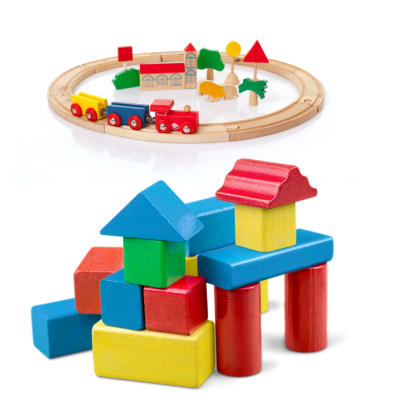Are Wooden Toys Better for Babies and Toddlers?

Are wooden toys better for babies and toddlers? Answer our poll to let us know your take and get THREE bonus entries into our giveaway!
Are Wooden Toys Better for Babies and Toddlers? Here's What Canadian Parents Should Know
As a new parent in Canada, you're likely being bombarded with advice about which toys are best for your baby or toddler. One question that often pops up: Are wooden toys better than plastic toys? From Instagram-worthy Montessori playrooms to eco-conscious parenting blogs, wooden toys are getting a lot of love — but are they really better for your child’s development, safety, and the planet?
In this article, we’ll explore the pros and cons of wooden toys, compare them to plastic alternatives, and help you decide what’s best for your baby or toddler.
What Are Wooden Toys, Exactly?
Wooden toys are made primarily from natural wood sources such as beech, maple, or pine. They can be simple blocks, puzzles, stackers, or intricately designed educational toys. Many wooden toys today are labeled as Montessori, eco-friendly, or non-toxic, appealing to parents seeking minimalist, developmentally-appropriate play.
Benefits of Wooden Toys for Babies and Toddlers
1. Durability
Wooden toys are long-lasting and built to endure rough toddler play. Unlike plastic toys that often break or wear out quickly, wooden toys can be passed down to siblings or even saved for the next generation.
2. Safe and Non-Toxic (When Properly Made)
High-quality wooden toys are usually finished with natural oils or non-toxic paints, making them safer for babies who love to mouth their toys. Be sure to look for toys labeled BPA-free, lead-free, and phthalate-free.
3. Encourages Open-Ended Play
Wooden toys are often simpler in design, which encourages imagination. A wooden block can be a car, a phone, or a building — helping toddlers develop creativity, storytelling skills, and critical thinking.
4. Supports Sensory and Motor Skills
Toys made of wood have a different weight, texture, and warmth compared to plastic. These sensory experiences support tactile development and fine motor skills in young children.
5. Better for the Environment
Eco-conscious parents will appreciate that wooden toys — especially those made from sustainably sourced wood — are biodegradable and produce less waste compared to plastic toys.
Drawbacks of Wooden Toys
While there are many positives, wooden toys do have some drawbacks:
Higher upfront cost: Quality wooden toys often cost more than plastic alternatives.
Heavier and harder: They can hurt more if thrown or dropped (yes, toddlers love to throw!).
Fewer sound/light features: If your child enjoys interactive lights and music, wooden toys may not satisfy that sensory craving.
Wooden Toys vs. Plastic Toys: What’s the Real Difference?
| Feature | Wooden Toys | Plastic Toys |
|---|---|---|
| Durability | ✅ Long-lasting | ❌ Often breaks easily |
| Safety | ✅ Non-toxic (if certified) | ❌ Can contain harmful chemicals |
| Imagination | ✅ Encourages open-ended play | ❌ Often screen-based or limited |
| Sensory Development | ✅ Natural textures | ❌ Smooth, less stimulating |
| Cost | ❌ Usually more expensive | ✅ Budget-friendly options |
| Environmental Impact | ✅ Eco-friendly | ❌ Non-biodegradable |
Where to Buy Wooden Toys in Canada
Looking for trusted places to buy safe and high-quality wooden toys? Here are some popular options for Canadian parents:
Indigo – Carries a beautiful selection of wooden toys and puzzles.
Well.ca – Offers eco-friendly, Montessori-inspired wooden toy brands.
Mastermind Toys – Features curated brands like Hape and Melissa & Doug.
Amazon Canada – Great for finding affordable sets with fast shipping.
Local shops and markets – Many Canadian artisans craft beautiful handmade wooden toys.
Tips for Choosing the Best Wooden Toys
Look for FSC-certified (sustainably sourced) wood.
Avoid toys with small, loose parts if your child is under 3 years old.
Check for CSA, CE, or ASTM safety certifications.
Choose toys that grow with your child, like stacking blocks, shape sorters, or activity cubes.
Final Verdict: Are Wooden Toys Better?
In many ways, wooden toys are better for babies and toddlers when it comes to safety, development, and sustainability. However, the best
toys are those that balance safety, engagement, and age-appropriate learning — whether they're wood, plastic, or fabric.
Many Canadian parents choose to incorporate a mix of wooden and plastic toys in the playroom.
Want more parenting tips and giveaways for Canadian families?
Join our community to access exclusive contests, baby freebies, and trusted product recommendations!